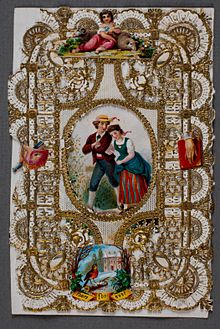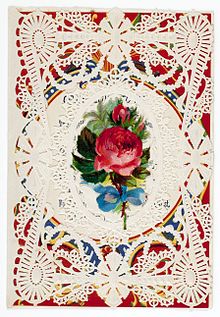Esther Howland (1828–1904) was an artist and entrepreneur who was responsible for popularizing Valentine's Day greeting cards in America.
Esther Allen Howland | |
|---|---|
| Born | August 17, 1828 |
| Died | March 15, 1904 (aged 75) |
| Nationality | American |
| Occupation | Founder of the New England Valentine Company |
| Years active | 1850-1880 |
| Known for | The Mother of the American Valentine |





Early life
editEsther Allen Howland, born in Worcester, Massachusetts, was the daughter of Southworth Allen Howland (1800–1882) and mother Mary Ware 1875. Her brothers were William, Samuel and Joseph Howland (See FamilySearch). Her father's first wife Esther Allen wrote the cookbook The New England Economical Housekeeper and Family Receipt Book, which was published in 1844 (and for the next ten years) by her father S. A. Howland.[citation needed] Her father operated S.A. Howland & Sons.[1] the largest book and stationery store in Worcester, Massachusetts.[2]
Howland graduated from Mount Holyoke College (then Mount Holyoke Women's Seminary) in 1847.[3]
Career
editShortly after graduating from Mount Holyoke College at the age of 19, Howland received a valentine card from a business associate of her father's.[4] The valentine was decorated with an elaborate fine lace border, ornate flowers cut-outs and a small pale green envelope in the center that contained a verse appropriate for Valentine's Day.[5] At this time, elaborate Valentine greeting cards were imported from Europe and not affordable to many Americans.[6]
Determined she could make a better card, Howland convinced her father to order supplies from New York City and England.[citation needed] She made a dozen samples that her salesman brother added to his inventory for his next sales trip[4] for their father's business.[7] Hoping for $200.00 worth of orders, Howland was elated when her brother returned with over $5,000 worth of business for her. [8]
Howland built a thriving business in Worcester, Massachusetts using an assembly line of friends to copy designs and help construct the cards. In the Howland's Residence on Summer Street, a guest bedroom on the third floor was set up for Howland's newly founded business. [citation needed Howland was in charge of cutting the basic design for the individual valentine while the assembly group was responsible for carefully copying each card.[1] Howland also hired women who had to work from home by preparing a box with all the materials required. A week later they would be picked up by a driver and turned to Howland for their inspection.[9] Howland reported that her girls were paid "liberally" and that work was "light and pleasant."[10] She would inspect every card that was produced by her assistants.[1] Her early cards contained short four-line verses pasted inside of them much like earlier English valentines. This model would eventually become standard for the American valentine market.[11] Although Valentine's Day cards had been available in America for more than half a century before Esther started her business, she was the first person to commercialize them in America.[1]
In 1850, her first advertisement appeared in the Worcester Spy.[11] Soon enough she found herself in the position of a businesswoman. She began to import materials from Germany.[citation needed] She also came up with the idea of using silk and embossing lithograph ornaments.[12] In order to distinguish her valentines, Howland began stamping the letter "H" on the back of her cards in red ink [11] along with the price and the letters ‘N.E.V.Co.’, which stood for the name of her company New England Valentine Company.[13] Cards that included ribbons, artistic illustrations, hidden doors, gilded lace[1] and interior envelopes that could hold more secret messages, locks of hair or even engagement rings ,[9] sold up to one dollar to fifty dollars. [citation needed] Howland also created cards for Christmas, new year, and birthdays, as well as cards, booklets, and May baskets.[1]
Howland suffered a knee injury in 1866 that forced her to be in a wheelchair.[14] In 1870, Howland incorporated her business as the New England Valentine Company.[citation needed] She continued to work from her home until 1879 when she moved to a factory.[citation needed] During that same year, Howland published The New England Valentine Co.’s Valentine Verse Book that consisted of 31 pages.[citation needed] The book was intended for customers who found a beautiful card but didn't like the verse that was inside. With the book they could choose from a total of 131 verses all printed in red, green, blue, and gold ink and came in three different sizes.[citation needed] With their chosen verse, customer could then paste it over the original verse in their card.[1] In 1870, Howland merged her business with one of her competitors, Edward Taft.[9]
Howland's cards were shipped nation-wide and her business eventually grossed over $100,000 per year. [citation needed] Howland eventually sold the business to a competitor, George Whitney, [2] in 1880 in order to take care of her sick father.[1] In 1904, Howland fractured a femur and was bedridden for eight months. She died in her home at 9 Adams St in Quincy.[citation needed]
Howland's valentine cards became renowned throughout the United States and after her death, she was called "The Mother of the American Valentine."[2] She is credited for the introduction of the "lift-up" valentine, which created layers of texture and color using lace, ribbon, and other materials.[15] Howland introduced the layering of lace, use of thin paper, three-dimensional accordion effects, and a bouquet in which flowers would move to reveal a verse when pulled by a string.[citation needed]
See also
editReferences
edit- ^ a b c d e f g h Terrell, Ellen (March 23, 2016). "Esther Howland and the Business of Love". www.loc.gov. Library of Congress. Retrieved November 13, 2016.
- ^ a b c Making Valentines: A tradition in America
- ^ "MHC Celebrates Valentine's Day". www.mtholyoke.edu. Retrieved 2022-02-15.
- ^ a b Naze, Jennifer (February 10, 2016). "Valentine's Day History". www.miningjournal.net. Mining Journal. Retrieved November 13, 2016.
- ^ Smith, Rita (February 9, 2006). "Esther Howland's Valentines". www.recess.ufl.edu. University of Florida's Center for Children's Literature and Culture. Archived from the original on August 4, 2019. Retrieved November 13, 2016.
- ^ Rosin, Nancy (April 2005). "Mother of the American Valentine". American History. 40 (1): 62–64.
- ^ "The Manufactured Valentine". The North Platte semi-weekly tribune. North Platte, Lincoln, Nebraska. February 9, 1917. Retrieved November 13, 2016.
- ^ "First American-Made Valentines Sold". www.massmoments.org. Retrieved 2022-02-15.
- ^ a b c Stocker, Lora (February 15, 2014). "You Should Know… Esther Howland". raleigh.aiga.org. AIGA. Retrieved November 13, 2016.
- ^ Lydon, Susan (February 14, 2011). ""Mother of the Valentine": Esther Howland, Worcester, and the American Valentine Industry". pastispresent.org. the American Antiquarian Society. Retrieved November 13, 2016.
- ^ a b c Wakeman, Carolyn (February 14, 2014). "Documents: Identifying Early Valentines". florencegriswoldmuseum.org. Florence Griswold Museum. Retrieved November 13, 2016.
- ^ "Valentines By Miss Esther Howland Are Exhibited". The Rock Island Argus and daily union. Rock Island, Rock Island County, Illinois. March 8, 1922. Retrieved November 13, 2016.
- ^ Hix, Lisa (February 11, 2016). "All You Need Is Paper: Why Antique Valentines Still Melt Modern Hearts". www.collectorsweekly.com. Market Street Media LLC. Retrieved November 13, 2016.
- ^ "All Hail Queen (of Hearts) Esther Howland". historyhoydens.blogspot.com. blogspot. February 11, 2009. Retrieved November 13, 2016.
- ^ Michelon, Christina (2016). "Touching Sentiment: The Tactility of Nineteenth-Century Valentines". Commonplace: The Journal of Early American Life. 16 (2).
External links
editMedia related to Esther Howland at Wikimedia Commons
- Worcester Historical Museum Archived 16 December 2005 at the Wayback Machine
- American Heritage